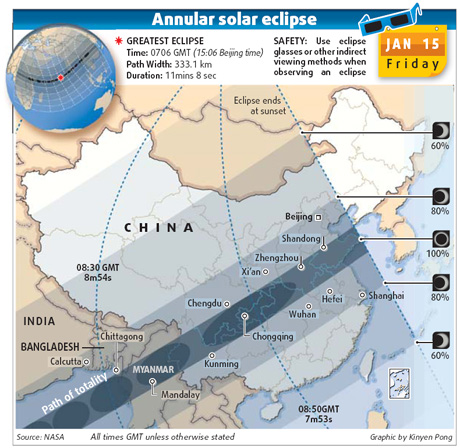Society
Once-in-a-millennium solar spectacle today
By Li Xinzhu in Shanghai and Guo Anfei in Yunnan (China Daily)
Updated: 2010-01-15 07:37
 |
Large Medium Small |

Astronomy buffs in China will enjoy fine weather conditions for observing a rare annular solar eclipse across a swath of the country in the afternoon today.
The longest annular eclipse for the next 1,000 years will be visible in some areas of Yunnan, Sichuan, Guizhou, Shaanxi, Hunan, Hubei, Henan, Anhui, Jiangsu and Shandong provinces, Cheng Zhuo, a researcher with the Purple Mountain Observatory under the Chinese Academy of Sciences, said yesterday.
A partial eclipse will be seen in most of the rest of the country, Cheng said.
An annular eclipse occurs when the Moon passes directly in front of the Sun but does not completely obscure it, thus leaving a ring - an annulus - of sunlight flaring around the lunar disk.
The last time it was seen in China was 23 years ago.
According to NASA's eclipse website, the Moon's shadow will strike the southwestern tip of Chad and western Central African Republic at 0514 GMT and then flit across Uganda, Kenya, and Somalia.
Its path then leads across the Indian Ocean, where the duration of "annularity" at 0706 GMT will be 11 minutes, eight seconds, making it "the longest annular eclipse of the 3rd Millennium," according to NASA.
The lunar umbra, or shadow, then zips across Bangladesh, India, Myanmar and China before expiring in Shandong's Jiaodong peninsula at 4:59 pm, local time.
People in a broader path of the shadow, which includes eastern Europe, most of Africa, and Asia, will see a partial eclipse.
The longest duration of the annularity on Chinese territory would be 8 minutes and 17 seconds in Ruili, Yunnan province, Cheng said.
Wang Sichao, also of the Purple Mountain Observatory, said that though an annular eclipse is not considered as spectacular as a total solar eclipse and is of little value in scientific research, it nevertheless makes for compelling viewing.
The National Meteorological Center forecast yesterday that today's fine weather, especially in Yunnan, will offer favorable conditions for observing the eclipse.
"I will travel to Dali in Yunnan with members of the Qimingxin Union," said Zhu Dayi, a spokesman for the Shanghai Astronomical Observatory. Qimingxin is funded by the observatory.
"I am going there to relive my first experience," said Lu Ming, a Qimingxin member who saw the annular solar eclipse in 1987.
"That was when my interest in astronomy was sparked, and I am glad to have the opportunity again," he added.
The best place in the world to watch the phenomenon today is in the Maldives but "I have to settle for Dali, because I only have one day off from work," said Lu, who works at Shanghai airport.
Many people are expected to flock to Dali for the event. "We are seeing a lot of astronomy fans these days," said Nima, the owner of a caf in Dali.
In that city alone, at least 250 are coming from around the world, said Su Hong, an astronomy fan in Kunming, the provincial capital.
Compared to other years, the number of eclipses this year is meager although they provide an "interesting mix" for watchers, the US magazine Sky & Telescope said in its January issue.
Apart from today's event, the only cover-up of the Sun this year will take place on July 11, when a total eclipse will cross the Pacific, visible notably from Easter Island, one of the world's remotest inhabited locations.
Total eclipses occur because of an unusual trick of celestial geometry.
The Sun is 400 times wider than the Moon, but it is also 400 times farther away. Because of the symmetry, the umbra, for those on the planetary surface, is exactly wide enough to cover the face of the Sun.
The orbits of the Earth and Moon are not completely circular, though. Tiny differences in distance explain why some eclipses are complete and others leave a thin ring of sunlight.
Xinhua and AFP contributed to the story












